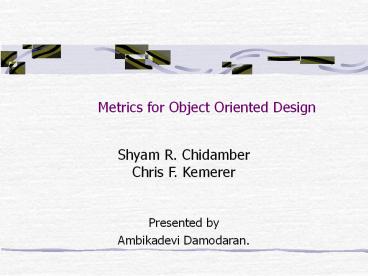Metrics for Object Oriented Design - PowerPoint PPT Presentation
Title:
Metrics for Object Oriented Design
Description:
Important properties Coupling and Cohesion are derived based on the above representations. ... Depth of inheritance of the class is the DIT metric for the class. ... – PowerPoint PPT presentation
Number of Views:86
Avg rating:3.0/5.0
Title: Metrics for Object Oriented Design
1
Metrics for Object Oriented Design
- Shyam R. Chidamber Chris F. Kemerer
- Presented by
- Ambikadevi Damodaran.
2
Introduction
- Existing OO Design metrics are subject to one or
more criticism. - There are lot of ongoing research for new suite
of metrics for OO design. - Four Major steps involved in Object Oriented
Design are - 1.Identifying Classes.
- 2.Identifying the semantics of classes.
- 3.Identifying relationships between Classes.
- 4.Implementation of classes.
3
Different Representations of OOD
- 1.D (A,R1Rn, O1..Om)
- A is a set of Object-elements,
- R1..Rn are relations,
- O1..Om are operations on A.
- 2.Viewed as collection of things with properties.
- Important properties Coupling and Cohesion are
derived based on the above representations.
4
Metric 1. Weighted Methods Per Class(WMC)
- Let a class be C1 with methods M1..Mn. Let c1cn
be the complexity of the methods. Then - WMC Summation of complexity c1cn
- View Points
- 1.The Number of methods and complexity of methods
involved is a predicator of how much time and
effort is required to develop and maintain the
class. - 2.The larger the number of methods in a class the
greater the potential impact on children, since
children will inherit all the methods defined in
the class. - 3.Classes with large numbers of methods are
likely to be more application specific, limiting
the possibility of reuse.
5
Metric 2. Depth of Inheritance(DIT)
- Depth of inheritance of the class is the DIT
metric for the class. DIT is a measure of how
many ancestor classes can potentially affect this
class. - View points
- 1.The deeper a class is in the hierarchy, the
greater the number of methods it is likely to
inherit making it more complex. - 2.Deeper trees constitute greater design
complexity, since more methods and classes are
involved. - 3.The deeper a particular class is in the
hierarchy, the greater the potential reuse of
inherited methods.
6
Metric 3. Number of Children
- It is a measure of how many subclasses are going
to inherit the methods of the parent class. - Viewpoints
- 1.Greater the number of children, greater the
reuse, since the inheritance is a form of reuse. - 2.Greater the number of children, the greater the
likelihood of improper abstraction of the parent
class. If a class has a large number of children,
it may be a case of misuse of sub classing. - 3. The number of children gives an idea of the
potential influence a class has on the design. If
a class has a large number of children, it may
require more testing of the methods in that
class.
7
Metric 4. Coupling between object classes
- Objects are coupled if one of them acts on the
other. - Viewpoints
- 1.More independent the class is, the easier it is
to reuse. - 2.The larger the number of couples, the
maintenance is more difficult. - 3.The higher the inter-object class coupling the
testing is more rigorous.
8
Metric 5. Response for a class(RFC)
- The response set of a class is a set of methods
that can potentially be executed in response to a
message received by an object of that class. - View points
- 1.With more number of methods, testing and
debugging is more complicated. - 2.The larger the number of methods that can be
invoked from a class, the greater the complexity
of the class.
9
Metric 6 Lack of Cohesion in Methods(LCOM)
- Lack of cohesion means, classes are not properly
encapsulated, so it means the classes can be
split into one or more subclasses. - View Points
- 1.Low cohesion means increased complexity.
- 2.Low cohesion also increases the likelihood of
errors.
10
Conclusion
- 1.These metrics reflects the viewpoints of OO
developers. - 2.These metrics can be used as a vehicle to
address consistency of entire application. - 3.By applying metrics, the areas that needs more
testing can be identified. - 4.Any one of the metrics can be chosen depending
on the needs of the organization.

